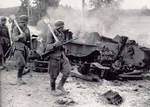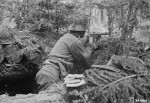Battle of Tali-Ihantala and Battle of Vuosalmi
Contributor: C. Peter Chen
ww2dbaseOn 9 Jun 1944, the Soviet Stavka ordered a general offensive against Finland to begin as an attempt to add pressure on the Germans, who was fighting a full scale invasion on the Normandy coast of France. Soviet Colonel General Dmitrii N. Gusev led 15 divisions, including veteran Guard units, against the Finns and quickly pushed the front back to the Vammelsuu-Taipale Line by the next day. On 12 Jun, Finnish leader Carl G. E. Mannerheim appealed for German reinforcement. On 14 Jun, the Finns attempted a counterattack and failed, leading to the Vammelsuu-Taipale being breached in return. On 16 Jun, Flight Detachment Kuhlmey (with about 60 aircraft) arrived in Finland, followed by 303 Assault Gun Brigade and the 122nd Division Grief in the next few days. The Finnish city of Viipuri (Vyborg) was captured by the Soviets on Jun 20. On 21 Jun, Finland attempted to start a peace negotiation, but Moscow in essence rejected it, demanding nothing but an unconditional surrender. On 22 Jun, German Foreign Minister Joachim von Ribbentrop arrived and demanded Finland to fight until the very end, which was accepted by Finnish President Risto Ryti. On the same day, Soviet tanks and infantry advanced at the village of Tali (Paltsevo) and village of Ihantala (Petrovka), east and north of Viipuri, respectively.
ww2dbaseThe terrain where the Soviets advanced was the only flatlands suitable for an offensive by armor on the Karelian Isthmus. Only 10-kilometers wide, the site of battle was flanked by lakes and the Vuoksi River. At this site, the later-named Battle of Tali-Ihantala was to be the largest battle in Nordic history.
ww2dbaseThe Soviet advance was met by the Finnish 18th Division, 3rd Brigade, and the ethnically-Swedish 3rd Battalion. The Soviet spearheading 97th and 109th Corps, supported by the 152nd Tank Brigade, attacked fiercely, but the Finns held their ground for five days.
ww2dbaseAt 0630 on 25 Jun 1944, a heavy artillery and air bombardment was conducted by the Soviets, and a major three-prong offensive against Tali began at 0730. The eastern prong east of Lake Leitimojärvi was stopped by the Finnish 4th Division, but on the western prong was able to breach Finnish defenses at Portinhoikka crossroads set up by Regiment JR48 with the aid of tanks from the 27th Tank Regiment; the third prong, an attack across the Saarela Strait by the Soviet 178th Division, was defeated by the Finnish Regiment JR6's 1st Battalion. Although only one of the three prongs succeeded, the Finns were now in danger of being cut off. Realizing this, the Finns gathered their reserve troops and mounted a counterattack which pushed the Soviets west of Lake Leitimojärvi back to the starting point, destroying the Soviet 27th Tank Regiment in the process and capturing several tanks.
ww2dbaseBy 27 Jun, both sides had bolstered their forces with reinforcement. The Finns attempted a large offensive with German and Finnish tanks and aircraft in support east of Lake Leitimojärvi, but heavy Soviet defenses and Finnish communications breakdown caused the Finnish offensive to fail. On 28 Jun, Finnish commander Karl Lennart Oesch ordered the Finns to fall back to the Vakkila-Ihantalajärvi-Kokkoselkä-Noskuanselkä Line; seizing this opportunity, the Soviets attacked during the transition, nearly routing the Finns by inflicting heavy casualties, but the Finns were able to re-establish a strong defensive line once again by 29 Jun.
ww2dbaseOn 2 Jul, Soviet 63rd Division and the 30th Armored Brigade received an order to attack Ihantala on the next day. This message of intercepted by the Finns, allowing the Finns and the Germans to stage an aerial attack at 0358, two minutes before the planned attack, and the 40 Finnish and 40 German bombers defeated the momentum of the Soviet attack before it was ever gained; 4,000 artillery shells from 250 guns were also fired in support. This concentrated pre-emptive strike delayed the Soviet attack until 0600; the attacking Soviet troops, supported by 200 aircraft, briefly disrupted Finnish lines. For the next several days, Soviet troops continuously tested Finnish defenses, but each time they were thrown back from concentrated and effective Finnish artillery bombardment. By 9 Jul, pressing needs in the campaign in Estonia led to Soviet troops being withdrawn from Tali-Ihantala, thus effectively ending the fighting from this region.
ww2dbaseSlightly away from the Tali-Ihantala area, on 4 Jul, Soviet 59th Army attempted an amphibious assault across the islands of the Bay of Viipuri in indirect support, but the invasion on the mainland were eventually pushed back into sea by the German 122nd Division on 10 Jul. Also on 4 Jul, Soviet 23rd Army attempted to cross Vuoksi River at Vuosalmi, which was promptly held within its small beachhead by the smaller Finnish 2nd Division. Finnish troops fell back away from the Äyräpää ridge near Vuosalmi on 9 Jul and re-established a defensive line on the northern shore of the Vuoksi River. As the Soviets built up strength in the Vuosalmi region, Finnish troops previously fighting at Ihantala arrived, halting the Soviet offensive and causing a stalemate in the region. Marshal Leonid Govorov, commanding officer of the Soviet Leningrad Front, became the scapegoat for the Soviet inability to make any gains at Vuosalmi.
ww2dbaseOn 12 Jul, Moscow ordered all offensives to cease in southern Finland and began to probe the Finns for possible peace terms.
ww2dbaseAlthough the Finns were out-numbered three to one at the start of this series of battles, effective defensive planning, particularly the heavy concentration of artillery (which was the greatest in Finnish history), led to a decisive Finnish victory. The Soviets suffered about 5,000 killed and 14,000 wounded, while the Finns suffered about 1,100 killed and 6,300 wounded. The Soviets also lost several hundred tanks and aircraft during the fighting. The Soviet defeats at Tali-Ihantala and Vuosalmi were the key events that convinced the Soviet leadership to maintain the status quo on the Finnish front, concentrating the forces against Germany instead. The Battle of Tali-Ihantala and the smaller Battle of Vuosalmi would become the final major battles of the Continuation War before Finland and the Soviet Union entered in a cease fire agreement on 4 Sep 1944.
ww2dbaseSource: Wikipedia.
Last Major Update: Feb 2008
Battle of Tali-Ihantala and Battle of Vuosalmi Interactive Map
Photographs
 |  |  |  |
Battle of Tali-Ihantala and Battle of Vuosalmi Timeline
| 9 Jun 1944 | Soviet Stavka ordered a general offensive against Finland. |
| 12 Jun 1944 | Carl G. E. Mannerheim appealed for German reinforcement to fight against the recent Soviet offensive. |
| 14 Jun 1944 | Finnish troops failed a counterattack against the recent Soviet offensive; Soviet troops pursued the withdrawing Finns and breached the Vammelsuu-Taipale defensive line in Finland. |
| 16 Jun 1944 | Additional German troops began arriving in Finland to counter the recent Soviet offensive. |
| 20 Jun 1944 | Viipuri, Finland was captured by the Soviets. |
| 21 Jun 1944 | Finland attempted to negotiate for peace with the Soviet Union; Soviets expressed that they would only accept unconditional surrender. |
| 22 Jun 1944 | Soviet troops reached the villages of Tali (now Paltsevo) and village of Ihantala (now Petrovka) near Viipuri, Finland (now Vyborg, Russia). |
| 22 Jun 1944 | German Foreign Minister Joachim von Ribbentrop visited Finland, offering German reinforcement against the recent Soviet offensive, but also demanding Finland to fight until the very end. Finnish President Risto Ryti agreed. |
| 25 Jun 1944 | Soviet troops launched a three-prong offensive at 0730 hours against Tali (now Paltsevo), Finland after a heavy artillery and air bombardment. Only the western prong breached Finnish lines, but it threatened to cut off the Finnish front lines. |
| 26 Jun 1944 | Finnish troops counterattacked Soviet troops west of Lake Leitimojärvi near Tali (Paltsevo), Finland, destroying the Soviet 27th Tank Regiment and pushing the Soviets back to the line the Soviets held one day prior. |
| 27 Jun 1944 | A Finnish-German offensive east of Lake Leitimojärvi in Finland resulted in failure. |
| 28 Jun 1944 | Karl Lennart Oesch ordered Finnish troops to fall back to the Vakkila-Ihantalajärvi-Kokkoselkä-Noskuanselkä Line in Finland. Soviet troops pursued the withdrawing Finns and caused heavy casualties. |
| 29 Jun 1944 | Finnish troops repulsed the pursuing Soviet troops and re-established the Vakkila-Ihantalajärvi-Kokkoselkä-Noskuanselkä Line in Finland. |
| 2 Jul 1944 | Soviet 63rd Division and Soviet 30th Armored Brigade were ordered to attack Ihantala, Finland (now Petrovka, Russia) on the following day. This message was intercepted by the Finns. |
| 3 Jul 1944 | At 0358 hours, having intercepted the intelligence that a Soviet offensive was to be launched on this day, 40 Finnish and 40 German aircraft attacked Soviet staging points in Finland, followed by an artillery bombardment. The Soviet offensive was delayed until 0600 hours, and it achieved little. |
| 4 Jul 1944 | In Finland, Soviet 59th Army attacked Viipuri and Soviet 23rd Army crossed Vuoksi River to attack Vuosalmi. |
| 9 Jul 1944 | Finnish troops withdrew from the Äyräpää ridge near Vuosalmi, Finland. On the Soviet side, a number of formations began to be withdrawn from the nearby Tali-Ihantala region for the campaign in Estonia. |
| 11 Jul 1944 | The full strength of Soviet 115th Corps was now located on the northern bank of the Vuoksi River in Finland. |
| 12 Jul 1944 | Soviet Union began probing Finland for possible peace terms after the Finns successfully repulsed Soviet offensives at the Tali-Ihantala region in Finland. |
| 17 Jul 1944 | The Soviet offensive near Vuosalmi, Finland ground to a halt. |
Please consider supporting us on Patreon. Even $1 per month will go a long way! Thank you. Please help us spread the word: Stay updated with WW2DB: |
» Aho, Martti
» Lennart Oesch
Location:
» Finland
 |
- » 1,160 biographies
- » 337 events
- » 44,601 timeline entries
- » 1,243 ships
- » 350 aircraft models
- » 207 vehicle models
- » 376 weapon models
- » 123 historical documents
- » 261 facilities
- » 470 book reviews
- » 28,636 photos
- » 429 maps
James Forrestal, Secretary of the Navy, 23 Feb 1945
Please consider supporting us on Patreon. Even $1 a month will go a long way. Thank you!
Or, please support us by purchasing some WW2DB merchandise at TeeSpring, Thank you!